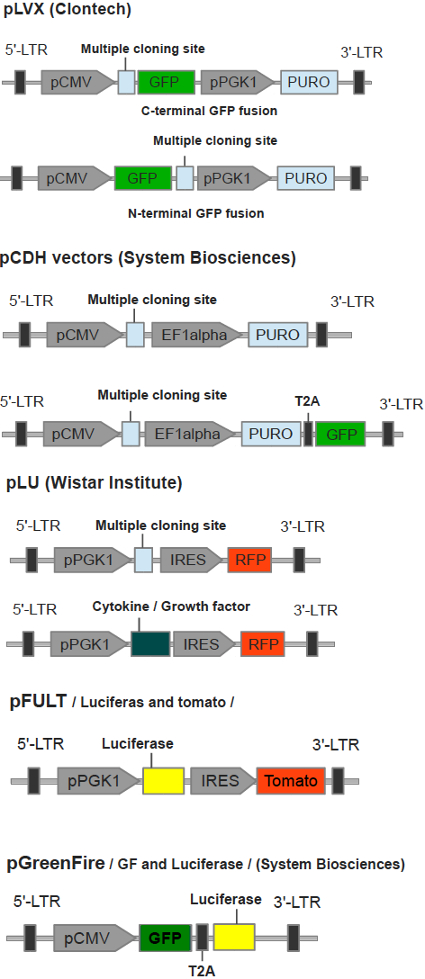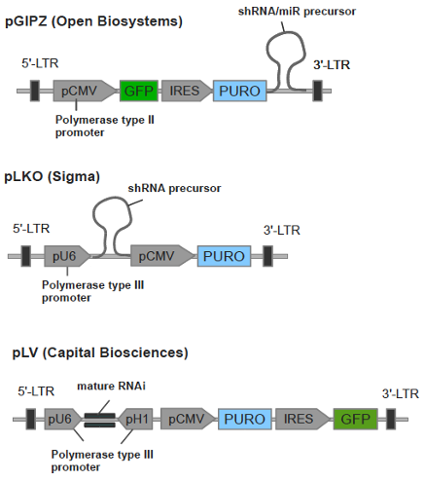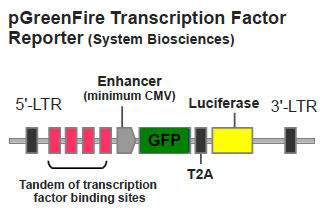Gene Editing Transduction & Nanotechnology Core
The Gene Editing, Transduction and Nanotechnology (GET iN) Core is directed by Irina V. Budunova, MD, PhD and Managing Director Pankaj Bhalla, PhD. The major objective of the core is to provide innovative customized solutions for cell engineering and gene expression modifications for in vitro and in vivo applications, including:
| Virus Type: | Lentivirus | Retrovirus | Adenovirus | Adeno-associated Virus |
|---|---|---|---|---|
| Target cell types: | Dividing/non-dividing | Dividing | Dividing/non-dividing | Dividing/non-dividing |
| Limit of DNA/RNA inserts: | 6.2kb-9.2kb | 5.5kb-8.0kb | 7.5kb-38kb | 4.2-4.7kb |
| Genomic integration: | Yes | Yes | No | No |
| Period of expression: | Long | Long | Short | Short |
| Viral titer: | Moderate | Moderate | High | Moderate |
| Envelop: | Tropism dependent | Tropism dependent | None | Serotype dependent |
| Work at Biosafety level: | BSL-2 | BSL-2 | BSL-2 | BSL-1 |
Core Services
Ordering is done through NU Core, and cost information is available via our core price sheet. Services include:
- Custom cells engineering and generation of customized experimental models for drug design, biomarker search and assessment of gene/protein functions and signaling pathways studies.
- Engineering of primary cells and immortalized cell cultures with stably expressed DNA/RNA. Examples of target cells include primary and immortalized skin human and mouse cells (keratinocytes, fibroblasts and melanocytes), primary bone marrow progenitors, human and mouse T and B cells, neurons and cardiomyocites, human IPSC and any other cell types provided by customers.
- Generation of viral expressing vectors (e.g., lentivirus, retrovirus, adenovirus), including vector design and production and cloning of DNA/RNA of interest.
- Generation and large-scale production of lentiviruses and retroviruses provided in two formats: standard titer: 107-108TU/mL QNE high titer: 109-1010 TU/mL at customized amounts.
- Generation and large-scale production of adenoviruses provided in flexible formats based on the customer requested amounts and titers with viral titer ranging 109 – 1012 TU/mL.
- Engineering of cells with custom CRISPR/Cas9 genome editing, including gene knock-down, gene knock-in, mutagenesis, in-genome protein tagging and CRISPR-libraries.
- Engineering of cells using CRISPR-epigenetic regulation of gene expression (requires customer’s consultation to start the project).
- Engineering of cells with gene knock-down using shRNA lentiviral libraries (Dharmacon, Sigma, Origene, Genecopaeia).
Lentiviral Vectors Available
The GET iN Core has tested and currently offers a variety of lentiviral expression vectors for protein and shRNA expression and the delivery of transcription factor reporters. These vectors are both commercial and internally acquired from core collaborators and patrons. The DNA/RNA delivery core offers vector maps and sequences and consults on approaches for cloning in the available vectors. Below you will find a short discussion of the vectors available from the GET iN Core.
Lentiviral vectors for protein expression

- pLVX family of vectors (Clontech) which contain CMV promoter that drivers expression of a cDNA, PGK promoter that controls expression of puromycine resistance gene. These vectors contain GFP to be expressed as protein fusion tag on either C or N terminus.
- pCDH family of expression vectors (System Biosciences) are the Core's most popular protein expression vectors due convenient design of their multiple cloning sites and optimized choice of promoters for control of protein expression (CMV) and expression of the antibiotic resistance gene (EF- 1alpha). CMV and EF1alpah promoters are most similar in the expression potential, although EF- 1alpha is slightly weaker than CMV, that provides high expression levels of both transgene and antibiotic resistance gene.
- pLU lentiviral vector (Wistar Institute) implied by the Core for expression of secreted proteins such as cytokines and growth factors. The vector harbors PGK promoter controlling expression of a protein of interest that is linked with RFP through IRES sequence. The PGK promoter provides robust expression in various human and mouse cell types with expression levels close to physiological.
- Protein expression vectors with pre-cloned ORF/cDNA encoding human and mouse proteins, such as pLV (Genecopaeia) and pLOC (Open Biosystems). Being typical lentiviral expression vectors, these are a good choice to acquire vectors that already contain an ORF/cDNA for protein of interest which is ready to be use for virus generation by the Core.
- Vectors for stable and robust cell labeling with fluorescent proteins (GFP, RFP, Tomato) and Luciferase for in vivo experiments on cells injected in to the animals. Vector pFULT vector expresses Luciferase linked to Tamato under the control of the human PGK1 promoter. Vector pGreenFire expresses GFP and Luciferase separated by a T2A link under control of the CMV promoter.
The core also carries lentiviral expression vectors that express different antibiotic resistance genes such as neomycine, blactocidine and puromycine. Therefore, if available, the core can offer generation of cell lines and primary cells stably infected with two and three proteins.
Lentiviral vectors for expression of shRNA/miR

The core has successfully used shRNA expressing vector from several major companies such as Sigma, Open Biosceinces and Capital Biosciences, that offer self-contained libraries of shRNA clones pre-cloned in their proprietary vectors.
- pGIPZ and its analogue pTRIPZ for inducible expression (Open Biosystems) express RNA under polymerase type II CMV promoter in a form of immature shRNA in the microRNA expressing cassette. These vectors offer tracking of the shRNA expression by GFP and selection of positive clones with puromycine. The pGIPZ library is available at a discounted price through the Northwestern University RNAi/Throughput Core which collaborates with DNA/RNA Delivery Core to generate shRNA expressing viruses for the NU community.
- pLKO family of vectors (Sigma) that offer RNA expression in a form of the immature shRNA under polymerase type III promoter U6. PLKO vector also allow for selection of the infected cells with puromycine.
- pLV vectors (Capital Biosciences) for expression of mature RNAi that does not require post-processing by DICER and DROSHA proteins. These vectors express mature RNAi duplex under U6 and H1 promoters control in a counter direction from 5'and 3' ends of the RNAi sequence. In addition these vectors offer expression of the GFP tracker and an antibiotic of resistance gene. The above bidirectional dual promoter design, allows the user to express and study function of a specific RNAi/miR in cell and animal models that lack expression of DICER and/or DROSHA, and therefore are considered to have no endogenous miRs.
Lentiviral vectors for delivery of transcription factor Luciferase reporters

Lentiviral expressing vectors delivering DNA binding elements for transcription factors upstream of Luciferase and GFP. These vectors are analogues of well-known Luciferase reporters used throughout for transient transfections of target cells to study activity of transcription factors. To date, the Core has acquired reporters for the following transcription factors: NF-kappaB, AP1, p53, HIF1alpha, TCF/LEF, NOTCH1, Steroid response element, human Involucrin promoter, Endoplasmic stress response element.
Core Leadership
Irina V. Budunova, MD, PhD
Core Director
Professor of Dermatology and Urology
Pankaj Bhalla, PhD
Managing Director
Contact Us
For more information, please contact Pankaj Bhalla, PhD, at 312-503-4192.